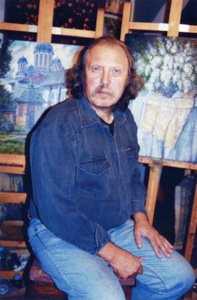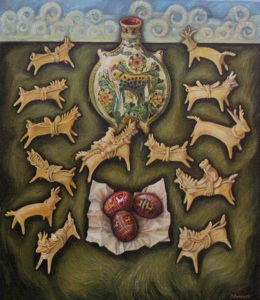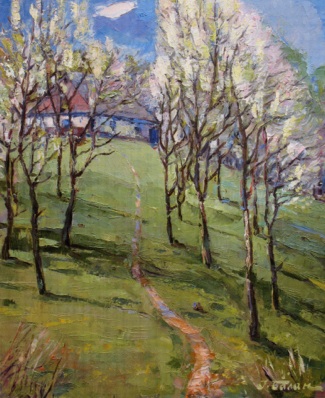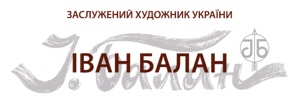Ivan Balan
Іван Балан
Ivan Balan
Іван Балан

Artist and Collector
Ivan Balan is a Ukrainian artist and collector who resides in Chernivtsi, in the Bukovyna ethnographic area of Ukraine. He was born in 1941 in nearby Podillya (Ternopil oblast), in the village of Strilkivtsi, on the banks of the Nichlava river, in the Borshchiv region. Ivan studied at Chernivtsi School of Art and Folk Crafts (1958-1961) and then, after completing his mandatory military service, studied at the Lviv Polygraphic Institute, where he learned the nuances of the graphic artist’s art.
Ivan has worked professionally as a graphic artist, but also paints gorgeous landscapes of his beloved Carpathian mountains, as well as still life's and ethnographically themed paintings. He is also an inveterate collector of all things antique and the folk arts. His house is like a museum–on one wall you will find hundreds of antique keys, in the kitchen the walls are covered with traditional plates, in the study are hundreds of Austrian postcards and ceramic Ukrainian whistles. In his studio are antique bottles and irons; in his living room an umbrella stand full of топірці (topirtsi), traditional Hutsul decorative axes. But I had never seen any pysanky in his house, except for a few in a painting.
Last year, at his birthday luncheon, he revealed to me that he had been collecting traditional Bukovynian pysanky for several decades, and had a thousand of them squirreled away. This year he allowed me to see and photograph them––as it turns out, there were only about 550 eggs altogether, including malyovanky and some Hutsul pysanky (plus another hundred or so “on loan” to a friend which I have yet to see). He, my cousin and I spent the better part of a day photographing them in his studio, under shifting light conditions.
The condition of the eggs was variable, as you will see in the photos. Some look almost new; in others the colors have faded or even run (some of the red dyes used in earlier years seem to have smeared and spread into adjacent areas.)
Ivan has tried several methods of preservation over the years, including filling the eggs with wax or paraffin and “reconstructing” them. The first (wax) method fell out of favor for several reasons, including that the beeswax attracted mice, who would eat through the shell to get at it, and that the wax often expanded, cracking the egg open in the process. (Examples can be seen on the malyovanka page below.) He then turned to “reconstruction”: to reconstruct an egg, he would cut it open with a fine knife, empty it, reinforce the shell with glue and other substances, and then glue the egg back together. You can see the lines where the reconstructed eggs were cut open quite clearly in the malyovanky; these lines tend to be much less conspicuous in pysanky.
To further protect and strengthen them, Ivan adds a coat of Damar varnish to the pysanky.
Ivan’s hope is to preserve these designs for posterity, not just through his physical collection, but by publishing these beautiful designs and hoping new generations will continue to write them. Interestingly, almost all of his Bukovynian pysanky come from a single village, Roztoky. It is amazing the number and variety of designs indigenous to such a small place.
The eggs on this page are (mostly) his non-pysanky: malyovanky, beaded pysanky and such. The traditional pysanky will be included in the regional pysanka section: Bukovyna, and Hutsulshchyna. I have included two sets of pysanky, though: one of “avtorska robota” (original designs), and another of pysanky with a church motif.
Please look at these eggs, enjoy them, and, by all means, copy them!
(Note: the numeration of these eggs, i.e. the “Балан - №,” simply reflects the order in which they were photographed and their data recorded. It is just my bookkeeping system.)




Back to MAIN Pysanka Galleries page
Back to MAIN Pysanka home page.
Back to Pysanka Index.
Search my site with Google